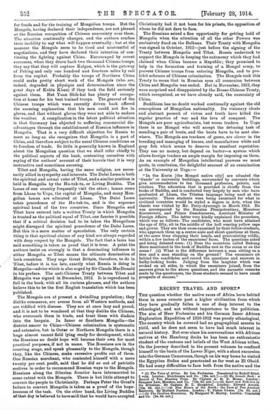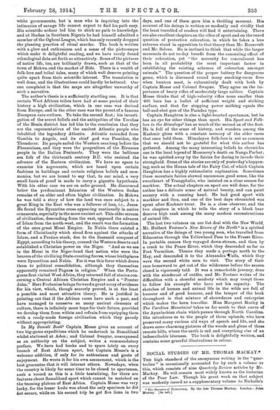RECENT TRAVEL AND SPORT.*
THE question whether the native races of Africa have behind them in some remote past a higher civilization from which they have gradually fallen is one of deep interest to the ethnologist, and not without importance to the politician. The aim of Herr Frobenius and hie German Inner African Exploration Expedition of 1910-1912 was purely ethnological, The country which he covered had no geographical secrete to yield, and he does not seem to have had much interest in natural history. But ever since his conversations with African natives at the Hamburg docks he has been an enthusiastio student of the customs and beliefs of the West African tribes. On the journey described in the present volumes he confined himself to the basin of the Lower Niger, with a short excursion into the German Cameroon, though on his way home he visited the Egyptian Sudan and penetrated as far west as El Obeid. He had many difficulties to face both from the native and the • (1) The Voice of Africa. By Leo Frobenius. Translated by Rudolf Blind. 2 vols. London : Hutchinson and Co. [2138. net.]—(2) My Somali Book Record of Too Sheeting Trips. By Coptala A. H. E. Moms. London Sampson Low, Marston, and Co. 1128. 5dr. set.]—(3) Sport and Folk-fora is the Himalaya. By Captain B. L. Naughton. London Edward Arnold. [12x. ad.net.]—(S) Re,, Bins. of the Nora: the Earn of Two Amateur :lersrs. B Hulbert Footner. London : T. Maher Unwire. [7s. ed. net.] —(5) The Carolina Mountaina. By Margaret W. Morley. London : Constabla pad Co. [5s. (kb net.]
white governments, but 'a man who is inquiring into the intimacies of savage life cannot expect to find his path easy. His scientific ardour led him to shirk no path to knowledge. and at Ibadan in Southern Nigeria he had himself admitted a member of the Ogboni League, which has only recently dropped the pleasing practice of ritual murder. The book is written with a glow and enthusiasm and a sense of the picturesque which make it delightful reading, and we have rarely found ethnological data set forth no attractively. Some of the pictures of native life, too, are brilliantly drawn, such as that of the town of Mokwa and the market of Bide. There is a wealth of folk-lore and tribal tales, many of which well deserve printing quite apart from their scientific interest. The translation is well done, and the illustrations could hardly be bettered. Our one complaint is that the maps are altogether unworthy of such a narrative.
The author's thesis is a sufficiently startling one. It is that certain West African tribes have had at some period of their history a high civilization, which in one Cans was derived from Europe, and in the other case was the parent of a famous European race-culture. To take the second first; his investi- gation of the secret beliefs and the antiquities of the Yorubas of the Benin district has led him to the conclusion that they are the representatives of the ancient Atlantic people who inhabited the legendary Atlantis. Atlantis extended from Gambia to Angola, and its chief god was Poseidon, the Thunderer. Its people sailed the Western seas long before the Phoenicians, and they were the progenitors of the Etruscan people in the Italian Peninsula. They were the bellicose sea folk of the thirteenth century B.C. who resisted the advance of the Eastern civilization. We have no space to examine his arguments, which are based upon certain fashions in buildings and certain religious beliefs and cere- monies, but we are bound to say that, to our mind, a very small basis of proof is made to carry a gigantic hypothesis. With his other case we are on safer ground. He discovered below the predominant Islamism of the Western Sudan remains of an older and often higher civilization. In Mokwa be was told a story of bow the land was once subject to a great King in the East who was a follower of Ism, i.e., Jesse- Be found the Byzantine cross appearing continually in native ornaments, especially in the more ancient art. This older stream of civilization, descending from the east, opposed the advance of Islam from the north-west, and the result was the formation of the once great Mos.si Empire. In Nubia there existed a form of Christianity which stood firm against the attacks of Islam, and a Persian stock, due to the Sassanid conquest of Egypt, according to his theory, crossed the Western deserts and established a Christian power on the Niger. "And so we see in the Mont in the Niger-bend that nation who were the bearers of the civilizing State-creating forces, whose birthplaces were Byzantium and Nubia. For it was this force which drove them to political consolidation, although they themselves apparently remained Pagans in religion." When the Portu- guese first visited West Africa, they returned full of stories con- cerning a Central African Christian Empire and a "Prester John." Herr Frobeniue brings forward a great array of evidence for his view, which, though scarcely proved, is at the least a possible and most attractive theory. He is justified in pointing out that if the African raoes have such a past, and have managed to conserve so many ancient elements of culture, there is infinitely more hope for their future, provided we develop them from within and refrain from equipping them with a ready-made foreign civilization which they parody without appropriating.
In My Somali Rook' Captain Mouse gives an acconnt of two big-game expeditions which he undertook in Somaliland whilst stationed at Aden ; and Colonel Swayne, unsurpassed as an authority on the subject, writes a commendatory preface. We have bad books and to spare lately on every branch of East African sport, but Captain Mosse's is a welcome addition, if only for its enthusiasm and gusto of enjoyment. He wrote it for his own amusement, which is the best guarantee that it will interest others. Nowadays, when the country is likely for some time to be closed to sportsmen, such a record as this is a little tantalizing, for there are features about Somaliland sport which cannot be matched on the teeming plateau of East Africa. Captain Moose was very lucky, for the lesser kuda was about the only specimen he did ilot secure, while on his second trip he got five lions in two days, and one of them gave him a thrilling moment. His account of his doings is written so modestly and vividly that the least travelled of readers will find it entertaining. There are also excellent chapters on the ethos of sport and on the vexed question of protective coloration, in which he takes a less extreme stund in opposition to that theoly than Mr. Roosevelt and Mr. Selous. He is inclined to think that while the larger mammals do not to-day benefit from the concealing effect of their coloration, yet "the necessity for concealinent has been in all probability the most important factor in establishing the existing schemes of coloration amongst animals." The question of the proper battery for dangerous game, which is discussed round many smoking-room fires when hunters meet, is exhaustively dealt with both by Captain Moose and Colonel Swayne. They agree on the im- portance of heavy rifles of moderately large calibre. Captain Moose thinks that of high-velocity rifles none smaller than 400 bore has a bullet of sufficient weight and striking surface, and that for stopping power nothing equals the ball-and-shot gun of the Paradox type.
Captain Haughton is also a light-hearted sportsman, but he has an eye for other things than sport. His Sport and Folk- Icre in the Himalaya" has as much of the second as of the first. He is full of the sense of history, and wanders among the Kashmir glens with a constant memory of the older races that once held them. Himalayan folk-lore is not so common that we should not be grateful for what this anther has gathered. Among the many interesting beliefs he chronicles one is the local legend of Mummery's death on Hauge Parbat; he was spirited away by the fairies for daring to invade their stronghold. Some of the stories are only of yesterday's happen- ing, such as the Hunza tale of the Fairy Cat, of which Captain Haughton has a highly rationalistic explanation. Sometimes these mountain fairies showed uncommon good sense, like the sweetheart of Trangphalio, who insisted on a close season for markhor. The actual chapters on sport are well done, for the author has a delicate sense of natural beauty, and can paint scenery with a cunning hand. He bad good sport with markhor and ibex, and one of the best days chronicled was spent after Kashmir trout. Be is a close observer, and the two chapters in which he tells the story of a black bear deserve high rank among the many modern reconstructions of animal life.
The last two volumes on our list deal with the New World, Mr. Hulbert Footner's New Rivers of the North' is a spirited narrative of the doings of two young men, who travelled front Edmonton through the Yellowhead Pass to the Fraser River. In portable canoes they voyaged down-stream, and then by a creek to the Peace River, which they descended as far as Fort Vermilion. Thence they made a portage north to the Hay, and descended it to the Alexandra 'Valls, which they were the second white men to visit. The story of their race homeward to get out of the wilderness before the season closed is vigorously told. it was a remarkable journey, done with the slenderest of outfits, and Mr. Footner writes of its difficulties with a cheerful modesty which may tempt those to follow his example who have not his capacity. The sketches of human and animal life in the wilds are full of humour and of good humour, and the temper of the book throughout is that mixture of shrewdness and enterprise which makes the born traveller. Miss Margaret Morley in The Carolina Mountains" takes us far south to that curve of the Appalachian chain which passes through North Carolina. She introduces us to the people of these uplands, who have preserved many curious old ways of speech and life, and she draws some charming pictures of the woods and glens of these remote hills, where the earth is red and everything else of an indescribable blueness. The book is delightfully written, and contains some graceful illustrations in colour.















































 Previous page
Previous page